Avete mai provato ad aprire uno dei vostri post su WordPress per poi essere accolti da un errore 404? A volte ci capita quando lavoriamo sui nostri siti WordPress o aiutiamo i nostri utenti a risolvere il problema.
Questo errore si verifica quando si riesce ad accedere all’area di amministrazione di WordPress e al blog, ma quando si cerca di aprire un post specifico, viene visualizzato il messaggio “404 Not Found”.
Può essere frustrante vedere i propri contenuti apparentemente scomparire, ma abbiamo trovato alcune soluzioni per risolvere questo problema. In questa guida completa, vi mostreremo come risolvere i post di WordPress che restituiscono errori 404.

Perché gli articoli di WordPress restituiscono un errore 404?
Ci sono diversi motivi per cui i vostri post potrebbero mostrare un errore 404 “Pagina non trovata” in WordPress. Questi possono essere:
- Conflitti tra plugin o temi: A volte, i plugin o i temi installati sul sito possono interferire con il modo in cui WordPress gestisce i permalink. Ciò può causare la rottura dei colleghi e la comparsa di errori 404.
- Problemi di codice personalizzato: Se avete aggiunto del codice personalizzato al vostro sito web, potrebbero esserci errori nel codice che influenzano i permalink o causano altri conflitti, con conseguenti errori 404 per gli articoli.
- Problemi con il file .htaccess: Il file .htaccess svolge un ruolo nel modo in cui WordPress struttura gli URL. Se questo file è danneggiato o mancante, può causare errori 404 per i post o le pagine.
Come trovare tutti i post di WordPress con errori 404
Prima di passare alle soluzioni, sarebbe bene capire se l’errore si verifica solo in uno o due post o in più post. In questo modo, è possibile determinare la portata del problema e scegliere la soluzione più appropriata.
Un modo semplice per scoprirlo è utilizzare Google Search Console. Se non avete ancora inviato il vostro sito a Google Search Console, leggete la nostra guida su come aggiungere il vostro sito WordPress a Google Search Console.
Una volta che il bot di Google ha effettuato il crawling e l’indicizzazione del vostro sito, Google Search Console vi fornirà informazioni dettagliate sulle prestazioni del vostro sito, compresi gli errori 404 che incontra.
Per scoprire quali post restituiscono errori 404, è possibile accedere alla dashboard di Search Console. Quindi, navigate nel report “Pagine” e vedrete un elenco dettagliato di tutti gli errori.
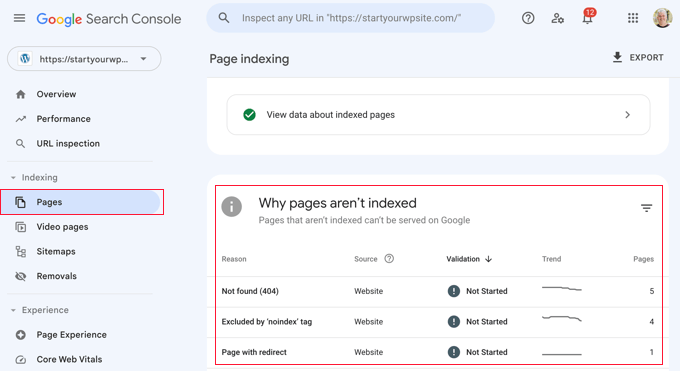
Per ulteriori informazioni, potete leggere il nostro elenco di suggerimenti per l’utilizzo di Google Search Console per aumentare il traffico del sito web, che include alcuni consigli su come risolvere gli errori 404 con lo strumento.
Detto questo, vediamo come correggere gli articoli di WordPress che restituiscono errori 404. Potete usare i colleghi qui sotto per passare direttamente alle diverse soluzioni:
Non avete tempo di risolvere da soli gli errori 404? I Servizi Pro di WPBeginner possono aiutarvi! Con la nostra conveniente Assistenza WordPress d’emergenza, potete assumere esperti per risolvere errori 404, link rotti, problemi di reindirizzamento e molto altro. Smettete di stressarvi per i problemi di WordPress e correggeteli! Programmate oggi stesso un servizio di assistenza WordPress di emergenza!
Metodo 1: Verificare la presenza di conflitti tra plugin o temi e problemi di codice personalizzato
A volte, i plugin, i temi o il codice personalizzato che avete aggiunto al vostro sito WordPress possono interferire con i permalink o causare conflitti, causando errori 404. Lo abbiamo sperimentato anche noi quando stiamo testando gli strumenti sul nostro sito demo.
Un modo per risolvere questo problema è disattivare temporaneamente i plugin. I plugin possono talvolta disturbare il modo in cui WordPress gestisce i colleghi.
Una volta disattivati i plugin, è possibile riattivarli uno per uno, selezionando se l’errore 404 ricompare dopo aver attivato ciascun plugin. Se l’errore compare dopo aver attivato un plugin specifico, il colpevole potrebbe essere quello.
È quindi possibile effettuare una rapida ricerca su Google per trovare soluzioni relative a quel plugin o contattare lo sviluppatore del plugin per ottenere assistenza.
Allo stesso modo, il tema di WordPress potrebbe essere la causa del conflitto.
Per selezionare, è possibile passare temporaneamente a un tema predefinito di WordPress, come Twenty Twenty-Three o Twenty Twenty-Four. Basta andare in Aspetto “ Temi e fare clic su ‘Attiva’ su un tema predefinito.

Se l’errore 404 scompare con il tema predefinito, ciò indica un potenziale conflitto con il tema corrente. Si può quindi provare a risolvere il problema del tema o prendere in considerazione l’utilizzo di un tema diverso.
Potete consultare la nostra selezione di esperti dei temi WordPress più popolari per avere consigli.
Se di recente avete inserito degli snippet di codice nel vostro sito web, potrebbero esserci degli errori nel codice che causano l’errore 404. Esaminate attentamente il codice che avete aggiunto e vedete se riuscite a individuare qualche errore.
Il modo più sicuro per aggiungere frammenti di codice a WordPress è il plugin WPCode. Questo plugin consente di inserire codice personalizzato senza intervenire direttamente sui file del tema, riducendo il rischio di rottura del sito web.
Inoltre, ogni volta che WPCode individua un errore nel codice, disattiva automaticamente lo snippet e chiede di selezionarlo. È anche possibile utilizzare la modalità di test per verificare se il codice funziona prima di inviarlo al sito web.

Se nessuna di queste soluzioni funziona, passate al metodo successivo, che prevede la risoluzione dei problemi relativi alle impostazioni dei permalink.
Metodo 2: correggere le impostazioni dei permalink
Gli articoli di WordPress possono restituire errori 404 a causa di problemi con le regole di riscrittura nel file .htaccess. Nella maggior parte dei casi, è possibile correggere il problema aggiornando le impostazioni dei permalink.
Basta andare su Impostazioni ” Permalinks nell’amministrazione di WordPress e fare clic sul pulsante “Salva modifiche”.

Non è necessario modificare le impostazioni dei permalink. Questa operazione aggiornerà le impostazioni dei permalink e cancellerà le regole di riscrittura.
Nella maggior parte dei casi, questa soluzione corregge l’errore 404 degli articoli di WordPress. Tuttavia, se non funziona, probabilmente è necessario aggiornare manualmente il file .htaccess.
Metodo 3: Aggiornamento del file .htaccess di WordPress
Prima di iniziare, assicuratevi di eseguire un backup del file .htaccess di WordPress. Se qualcosa dovesse andare storto, potrete facilmente ripristinare il file originale.
A questo punto, è necessario connettersi al server utilizzando un client FTP come FileZilla o l’applicazione File Manager nella dashboard del vostro hosting WordPress.
Successivamente, dovrete trovare e modificare il file .htaccess, che si trova nella stessa posizione di cartelle come /wp-content/ e /wp-includes/.
È sufficiente fare clic con il tasto destro del mouse sul file e selezionare “Autorizzazioni file”.
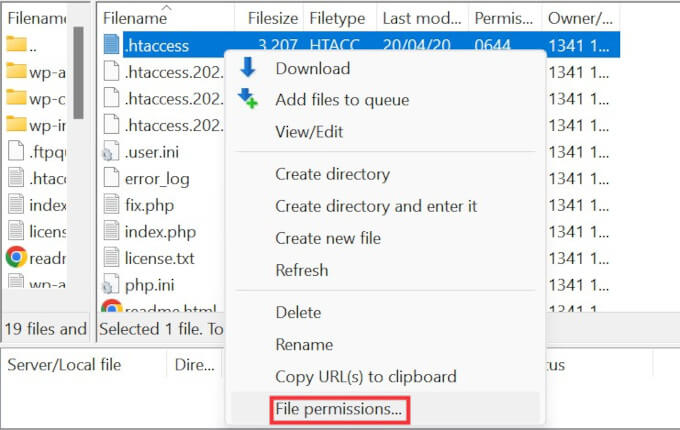
È possibile rendere il file scrivibile cambiando le autorizzazioni a 666.
Inserite semplicemente “666” nella casella “Valore numerico” e fate clic su “OK”.

Quindi, è necessario ripetere i passaggi del primo metodo del nostro tutorial. Una volta fatto questo, non dimenticate di modificare le autorizzazioni in 660.
È anche possibile modificare il file e aggiungervi del codice.
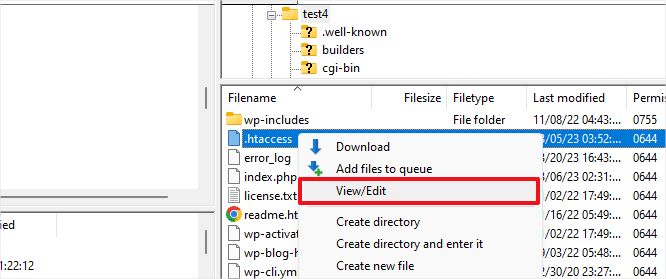
Una volta aperto il file .htaccess con un editor di testo, è sufficiente inserire questo codice:
# BEGIN WordPress
<IfModule mod_rewrite.c>
RewriteEngine On
RewriteBase /
RewriteRule ^index\.php$ - [L]
RewriteCond %{REQUEST_FILENAME} !-f
RewriteCond %{REQUEST_FILENAME} !-d
RewriteRule . /index.php [L]
</IfModule>
# END WordPress
Metodo 4: contattare il fornitore di hosting
Se nessuna delle soluzioni sopra descritte ha corretto l’errore 404 degli articoli di WordPress, vi consigliamo di contattare il vostro fornitore di hosting WordPress. Potrebbe trattarsi di un errore on loro, oppure potrebbero aiutarvi a risolvere il problema.
NON SI TRADUCE la nostra guida su come richiedere correttamente l’assistenza WordPress e ottenerla.
Metodo 5: Abilitare il mod-rewrite (installazione locale di WordPress)
Se si utilizza un server locale a scopo di test, è necessario abilitare il mod_rewrite nella configurazione Apache del sito MAMP, WAMP o XAMPP.
Questo permetterà a WordPress di generare URL puliti e di evitare l’errore 404 per articoli e pagine sul server locale.
Il modo in cui farlo varia a seconda della piattaforma utilizzata. Chi usa XAMPP può aprire il proprio pannello di controllo e fare clic sul pulsante “Config” all’interno di Azioni. Quindi, selezionare “Apache (httpd.conf)”.
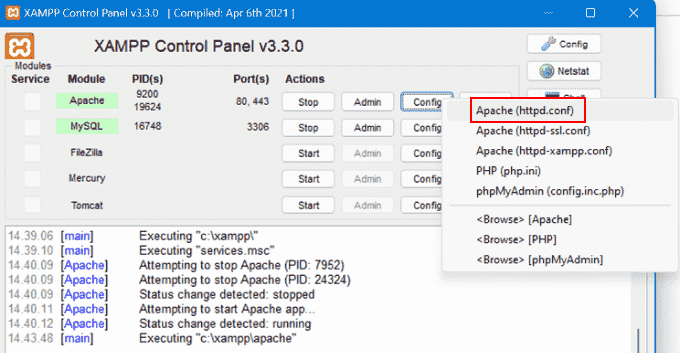
Successivamente, è necessario trovare questa riga #LoadModule rewrite_module modules/mod_rewrite.so e rimuovere il ‘#’ per decommentarla.
Questo caricherà il mod_rewrite.
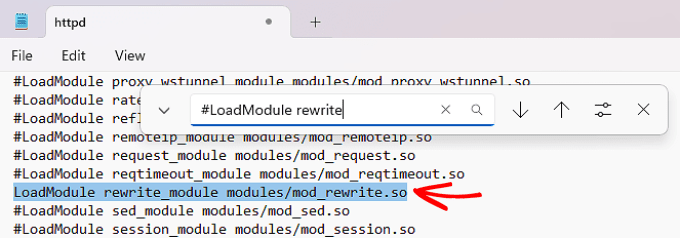
Quindi, individuare tutte le istanze di AllowOverride None e modificarle in AllowOverride All.
Il valore “Tutti” significa che tutte le direttive possono essere sovrascritte.

Una volta fatto, si può salvare il file httpd.conf e chiuderlo. Dopodiché, nel pannello di controllo di XAMPP, fate clic su ‘Stop’ sul modulo Apache e su ‘Start’ per riavviarlo.
Poi, tornate alla vostra Bacheca per vedere se i permalink funzionano.
Video tutorial
Se avete bisogno di istruzioni visive, guardate il video qui sotto.
Speriamo che questo articolo vi abbia aiutato a risolvere i post che restituiscono errori 404 in WordPress. Potreste anche voler consultare la nostra guida agli errori più comuni di WordPress e a come risolverli, insieme alle scelte dei nostri esperti sui migliori plugin WordPress per far crescere il vostro sito.
Se questo articolo vi è piaciuto, iscrivetevi al nostro canale YouTube per le esercitazioni video su WordPress. Potete trovarci anche su Twitter e Facebook.





Laxmi Prasanna
thank you very much. you saved my day. god bless you
chandan
you save my day
Alessandro Morotti
Thxs a lot man.
Your save my job!!!
congratulations by your time
Niketa
Many many Thanks.. I was worried first but your blog fixed my 404…as I was having exactly same issue.
Abhishek Sharma
Sir i dont know how to thank you.. But today you saved my life.. I was so scared. I just published a post and then when i checked that in my browser it showed 404 error then i check another post and then all . i was surrounded by 404 errors except my homepage was working. Now before posting to wordpress forums i just googled it and found solution on your website.,..
Mannn Thanks for saving my life.
WPBeginner Support
Hi Abhishek,
We are glad you found this article helpful. Don’t forget to follow us on Facebook for more WordPress tips and tutorials.
Admin
Richard
Hi !
I doesn’t work for me.
i added ” . ” for prefix category but i fall in a 404 page when i try to access to my subcategory :s
CR
Awesome! It helped.
Paola
I LOVE YOU! I didn’t knew how to fix this I’m a complete novice. Thank you thank you! !
Marlena
I’m so pleased to have found this article first. I’m a complete novice and I fixed my own 404 issue.
YAY!
Thanks so much!
Saud Razzak
Very informative and useful article for WordPress beginners!
Eri
Please can you help me for this, because I tryied but i cant fix it :/
Tom C
Great guide! Totally solved my issue.
Anil
I have created a subdirectory. And I have two wordpress installed, one in root and the other in subdirectory. Both of them contains posts and pages. I want to access both and it’s happening. But when I am hiding the subdirectory slug from the post URL by modifying the .htaccess file, the sub directory name got hidden as per the requirement but the posts of my main domain is inaccessible and getting 404 error. I want to access the post from both root as well as subdirectory. Please suggest.
Jawad
Thank you very very much for your help
Farukh Hussain
Thanks alot for sharing. Your tutorials always helps me.
Karen
Thank you so much for this!
Grant Turner
Fixed. My problem was since I’m running on a windows server then I don’t have a .htaccess file. I need to create a web.config file.
Cindy Martin
This fix DID NOT work for me! I still have a 404 error on my blog page only. I am using Gridalicious and have had nothing but trouble! (Not with Gridalicious but other stuff too).
I removed everything from the to start over. loaded the theme and get the error.
Blog posts are not showing up on the blog page except in the widget and the main page is the 404 error message. Saving permalinks does nothing at all. Host is GoDaddy. HELP! I’m really tired of all this and frustrated.
WPBeginner Support
Hey Cindy,
This seems like an issue with your WordPress theme. Please follow the step by step instructions in our WordPress troubleshooting guide. It will help you figure out what’s causing the issue.
Admin
Maranna
Thanks! I moved website from one server to another and had the problem with posts returning 404. Main page and admin were working fine. Re-saving permalinks worked to fix this problem. Seems that this setting is not carried over correctly in all cases.
Aondongu Tivzenda
The permalinks fix worked perfectly. Thank you for this website. Awesome!
alvin
My problem is funny. I have a couple of WP websites I am currently running each logged into one browser with different portals and logging user names. After I noticed the 404 error checking the redirect area i see my author names have been mixed up from all the different websites. Can someone please assist
niranjan
It worked! Thanks!!
Vishwa
It worked! Thanks!!
Yours is a great website!
Charley Gordon
Thanks for sharing your knowledge.
Al
Thanks, worked for me
Mayapur Voice
This post saved my day today! In an attempt to fix a long standing problem today our host changed the .htaccess file. The issue got resolved but it broke all my links. By the grace of God, I found this post in an instant and it was exactly what I needed. Thanks tons!
marcela bonadio
exactly what i needed. thanks for sharing your knowledge.
Casey
Hello, thanks for this article and all the other awesome articles I have found on wpbeginner. I am running into some problems with my front page giving me an “oops! That page can’t be found” error. I am wondering if you have any advice on how to fix it.
I am running:
LAMP with Debian 3.2.84-1 x86_64 (Wheezy) on a VPS, Apache 2.2.22, php5
Wordpress: 4.7.1
Theme: YS Magazine
The original issue occurred when I switched the permalink structure to use “post type” instead of the default. At that point I could no longer view any of my pages and just got a 404 error. So, I did some research and edited my .htaccess file to allow overwrite. This fixed the problem of the 404 errors on all my pages, except on whatever page is set to my home page. To be clear, there was no problem with any of the pages before I changed permalinks. It also does not matter if I set the front page to static or posts. If I change my front page to another page I can then see the page which was set previously as the front page, but the new front page then gives me the error.
I have tried:
disabling all my plugins and enabling them one by one
changing themes
changing the .htaccess file back
changing permalink settings
I have been searching for an answer to this for hours now and seem to have ran into a brick wall. Any help would be super appreciated. Thank you so much.
Bart Dority
Thank you so much for this post!
I knew my 404 errors had something to do with the permalink structure – and I even tried changing the permalink structure and saving it – and otherwise updating and refreshing it — but it still wasn’t working. But then I read this post which said — instead of changing the permalink style and saving it, — just leave it where it is, and click Save anyway. That worked for me. A huge relief. Thank you!
Angelica
Thank you so much!! It worked!!
MarcB
Thank you so much for this help. Really a lifesaver.
Elyes Gherib
Thank you very much, this did it for me!
Z
Thanks for the post. I’ve had to deal with other problems after switching hosting providers, but this was a new one.
I did the method provided and my site was back to normal within seconds.
Kristine
Hello, I am hoping you can help me- I am super nervous about my wp site right now. When I type the address into the search engine it is a completely barebones site that says it is “set up through Wix” that no longer looks like our site we have been operating through wordpress. This just happened out of the blue and I am so nervous about our posts.
WPBeginner Support
Hi Kristine,
It seems like your WordPress site’s domain is hosted by Wix. If you have login details for a wix account, then you can login and point the domain to your current WordPress hosting provider. If you are unsure, then please try contacting Wix support and your WordPress hosting provider support for more help.
Admin
Jolene
Thank you! My blog has been down and I couldn’t figure out how to fix. In a last ditch effort before I call customer support…I googled. You saved the day!
Bruno Almond
Great blog here! Additionally your site rather a lot up very fast! What host are you the usage of? Can I am getting your affiliate link in your host? I desire my web site loaded up as fast as yours lol
WPBeginner Support
Hi Bruno,
WPBeginner is hosted on a HostGator dedicated server.
Admin
AJ
great job mate, you did a better job than the tech support at bluehost
Lorene
No, this worked for the one post that was showing Error 404, but then ALL the others that worked before, now show Error 404. So I had to change it back. Hope most of them work now.
Gabe DeFrates
Excellent tip for fixing the permalink! I was getting the “File not found” error, and I went right into the WP Control Panel Settings, Saved Changes and she’s working again. You saved the day! Thank you for your time in posting this.
Samnang Thorng
Thanks I can deal with site now. Great helps
jhonny
Recently I have changed my site permalinks and now i am getting lots of 404 errors i have redirected them some of them to new url and others to homepage but still my site users were going down and down what to do now help me please should i change them back to old permalinks? or something else to do please tell me
Exxagon
Thanks a lot for your post.
Since many weeks, I was stucked with a 404 error each time I tried to change my permalinks structure.
I found the solutions in your post :
1. Modify /etc/apache2/apache2.conf, and set “AllowOverride All” everywhere instead of ” AllowOverride None”
2. Empty /var/www/html/.htaccess completely, change it to www-data:www-data & set it temporary to 777.
3. And the main one : “sudo a2enmod rewrite”, and “service apache2 restart”
Thanks again !!
Xavier
Asif
thanks bro it help me and my server version is working fine now
Suraj
Thanks a lot… It’s working for me.
Erwin
Hey, where can I find “/etc/apache2/apache2.conf”??? I don´t even know where to search? Do I need a special Application or something? Sorry, i´ve no idea : I
Abel
Hi, “/etc/apache2/apache2.conf” is a Ubuntu system folder. If you want to access it, you should have access to your server (like ssh).
Abel
Thanks a lot!
Vinita
Recently I am getting lots of 404 page errors in google webmaster. While revamping my wordpress website, instead of redirecting old urls to new, I just edited existing urls to new ones. e.g. website.com/url1 was edited to website.com/url2. Now webmaster if giving 404 error for old urls i.e. website.com/url1. How am I supposed to solve this error? (there are almost 155 urls with 404 errors so cant ignore)
WPBeginner Support
See our guide on how to setup redirects in WordPress.
Admin
Sandy
Is there a plugin that can find 404 errors and redirect them safely with best SEO tactics? Or should i do a edit find and replace in my xml file and remove the urls?
appreciate your ideas…
Michael
changing the right to 660 made my site unavailable. i had to set .htaccess to 644 (which was the original setting). regards Michael
Swadesh
Thanks a lot
Its working for me.
Kieron Atkinson
I’m running wordpress on a client’s in-house server and even though the htaccess file is there with the rewrite module sequence, permalinks are still not working. In fact all the URLs are coming up as example.com/index.php/permalink.
How do I check if the module rewrite is enabled on the server? My client says that they have that enabled but it still doesn’t work.
Many thanks for your help.
Kieron
Renee
Mahalo nui loa (thank you very much)!
Reassigning the Permalinks is exactly what was needed after moving 10 sites to a new hosting company.
Abundant blessings to you and your team.
WPBeginner Support
Hi Renee,
Glad you found it helpful and thanks for the kind words. You may also want to join us on Twitter for more WordPress tips and tutorials.
Admin
Steve
Thank you for your well written article. I have logged in to both /wp-content and /wp-includes/ and I havent found my .htaccess file.
Is it possible that I dont have one as I also get the 404 error if i try and redirect a page usin Redirection in WP.
Thanks in advance.
Steve
WPBeginner Support
Please see our guide on why you can’t find .htaccess file on your WordPress site.
Admin
Paras
hello
i am facing this same problem
i tried your method but still its showing error
Margarita
Today I was about to launch my web after 5 months working very hard in localhost. I was very happy but exhausted. While doing all the migration process, my site was gone. I had made a backup of course, but after trying a hundred times nothing worked. All seemed lost… until I found your post and it was solved in less than 30 min.
My day has been awful, a waste of many hours and energies. But now I go to bed with a smile in my face. Happy again. Infinite thanks.
Marga Rubio Soto
WPBeginner Support
You are welcome. We are glad you found the article helpful. Don’t forget to join us on Twitter for more WordPress tips and tutorials.
Admin